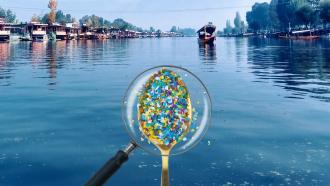
If there is one thing that’s found in cosmetics, synthetic clothes, human poop, table salt, or the thousands of turtles and fish living in the sea, it is microplastics. Microplastics are small, barely visible pieces of plastic, about a few millimetres in size, formed from plastic debris that break down into small pieces over time. They have now invaded the entire planet—from land to the mighty oceans, to the rivers and lakes. Every plastic bag or bottle that was not recycled, could end up as microplastics, polluting our water bodies and posing a severe threat to the health of the ecosystems and living beings.
In a first, a study by researchers at the Mahatma Gandhi University, Kottayam, Kerala, has reported that microplastics have been found in the sediments of the Vembanad Lake, a wetland ecosystem recognised internationally by the Ramsar Convention. The lake spread across the districts of Ernakulam, Alleppey and Kottayam, supporting different livelihoods such as agriculture, fisheries and clam collection. While the northern part of the lake is connected to the Arabian sea, five rivers flow into the lake on the southern side, mainly making it a freshwater lake.
The study found that the lake acted as a ‘sink’ for microplastics and had substantial levels of plastic particles in its sediments. The researchers classified them as ‘fibre’, consisting of thin or fibrous plastics, ‘pellets’ made of hard and round plastics, ‘fragments’ with hard, jagged plastics, ‘foam’ or light-weight plastic and ‘film’ or thin plastic. The foam and film types of plastics were found to be dominating in the Vembanad lake.
“Plastics consist of different polymers that can be buoyant, neutral, or can sink depending upon their composition, density, and shape. Polypropylene and polyethylene are typically low-density plastics that are expected to be relatively buoyant, while polyvinyl chloride (PVC), polystyrene, polyester, and polyamide are considered high-density plastics that are more likely to sink”, explains Prof EV Ramasamy from MGU, who led the study. Low-density polyethylene was the most abundant polymer, present in at least six out of ten samples in the lake.
The study found that the northern parts of the lake, influenced by the sea, had a higher abundance of microplastics than the southern side. The researchers point to the problem in the solid waste generated in the city of Kochi, where nearly 4%-6% of the municipal waste is plastic. Due to the lack of an efficient solid waste disposal system, the plastic debris gets washed into the surrounding water bodies, finally finding its way into the Arabian Sea.
“Microplastics discharged from Kochi and the industrialised area of Eloor, which are located north of Thanneermukkom bund, may also be the reason for the higher microplastics abundance found there”, says Prof Ramasamy. The Thanneermukkom bund divides the lake into the northern and southern parts. “The lake receives discharges from seven major rivers plus many streams and canals and is a sink for many contaminants, including heavy metals. As these rivers and streams flow through densely populated urban stretches, the possibility of occurrence of microplastics in the lake is high”, he adds.
Once the microplastics get into water bodies, they do not remain just there! They spread into the aquatic ecosystem affecting the food web – a natural interconnection of food chains. Fish and other aquatic life forms end up feeding on them, and eventually, they enter the food chain at all levels. Studies have reported negative physiological consequences in many marine animals when they feed on plastics. However, the potential impacts of microplastic contamination within the freshwater systems is yet to be understood.
“Considering that plastic is such a persistent substance within the environment, it is probable that the amount of plastic in the environment will steadily increase. Although large macroplastics can be manually removed from the environment to some extent, it would be impossible to remove even a small proportion of microplastic from the aquatic environment”, warns Prof Ramasamy. The only route that remains for us to escape from the mess of microplastics the controlled use of plastic, reduction in plastic waste generation at the source and to reuse and recycle what we already have.
The study is the first to scratch the surface on microplastic pollution from lake sediments in India, providing scope for extensive studies in the future. “The freshwater environment needs to become a priority for research into the abundance, fate and effect of microplastic”, signs off Prof Ramasamy.






